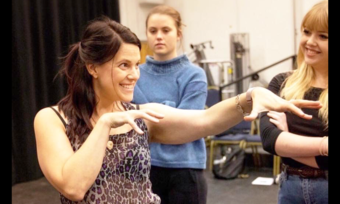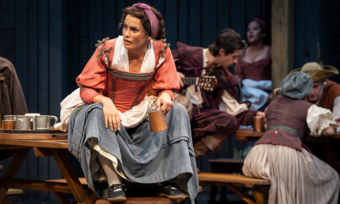1. Violence as scripting.
In her deeply significant book Rape on the Contemporary Stage, Lisa Fitzpatrick examines professor Sharon Marcus’s idea that the representation of sexual violence, such as rape, has the power to be scripted and, also, the power to script—meaning that through the writing and staging of such acts, social and cultural notions of sexual violence are created. In other words, gendered violence isn’t a single, unified idea or set of practices that are replicated constantly and in the same way across different productions. It is, in fact, a form of ideology that is lined in the choices we make. It is very much constructed, especially when it feels or looks accidental. Thinking about gendered violence as something we as performance-makers can actively script helps us identify how to change existing problems with traditional representations and stagings, issues such as the fetishization of women’s bodies, sexualizing violence against women, “miming” acts of violence, and relying on old tropes to convey them—and thereby reinforce them!—instead of imagining new narratives.
Gendered violence isn’t always specific acts of harm either: the tropes do as much ideological violence because they perpetrate misogynist stereotypes. Think about the sexualized adulteress, the promiscuous schoolgirl, the “mad” Black or Brown woman, the (white) manic pixie dream girl, the blonde who isn’t as sharp. Think about the scream of horror, or the “ruined” woman, or the absence of consent in sexual acts. These representations exist across film and theatre, and they are actively scripted each time. If we change how pleasure and consent are represented, we change pleasure and consent cultures in the world around us.
Violence against women isn’t exceptional and extraordinary; it is routine and banal. We need to challenge traditional dramaturgies that frame it as the former rather than the latter.
2. De-spectacling violence.
I am constantly dazed by the fact that enactments of gendered violence, especially in performance, are so spectacular. Not in a, “Wow did you see that?” way, but more in an, “Ugh was that really necessary?” kind of way. Violence against women may consist of explicit acts that feel like they’re out of the ordinary, but that’s not all it is, and it only appears to be so because we continue to lack a vocabulary and method to make such acts commonplace in dramaturgy. What if domestic violence wasn’t the premise for a character development arc? What if casual sexism (that phrase—what on earth is “non-casual” sexism, and how does it matter if it’s casual or not?!) wasn’t the main joke? And so on. Gendered violence as it plays out in performance needs to take a step back: its potency in representation arrives from its integration with the everyday lives of women. It happens to us every day. The banality of gendered violence is rarely a spectacle. Such violence is tedious, institutional, and hoary—our lives are not contained by it.
Last year, I tried to think about what it means to “de-spectaclize” grief and loss in women’s lives. I was the dramaturg for a fifteen-minute devised dance theatre piece by actor-dancer Namaha Mazoomdar titled “What is Fully Mature is Very Close to Rotting (after Clarice Lispector).” This was part of a longer performance titled Kaal: Dancing with Time, by Drutam Dance Ideas Lab in Mumbai, which explored time. Namaha wanted to showcase the rise and fall of a woman who grieves after she discovers the loss of a source of great joy.
We played with temporality and tried to devise different ways to mark the passage of time using speed, space, and repetition of movements. What proved to be a bigger challenge was showcasing the violence of loss without resorting to conventional signifiers like hysterics. What we did, instead, was make the loss part of her dramaturgical journey, after which she continues to grapple with grief. The costume consisted of nondescript colors and everyday clothing. Namaha played with the repetition of certain actions traditionally associated with despair, such as spinning by herself on stage, but by changing the tempo of these twirls and using the entirety of the space to execute them, she made the process of loss and the time taken to adjust to this loss more visible, rendering it less of an exceptional event. Grief is a turning point, a marker of a change, but it is not a spectacle.
3. Representation is more than legibility.
“I have a voice! Sometimes that voice is high-pitched – a grotesque scream. It is illegible,” writes Kate Zambreno in her chapbook Apoplexia, Toxic Shock, and Toilet Bowl: Some Notes On Why I Write.
“Mimicking” acts of violence against women in a performance context takes us back to the old conundrum of repeating conventional representations of violence. The first problem with relying on such conventions is that they have frequently evolved from appeasing patriarchal norms—acts of violence become sexy, titillating, metaphoric, and a source of voyeuristic pleasure. Secondly, realism or psychorealism as a style fudges the fact that violence against women is scripted (see point 1!) and therefore sets up irresponsible expectations for what such violence “looks like” outside the performance. Cue cries of “but that doesn’t look like a violation!” Maybe violation doesn’t look like that.
Representation of gendered violence is about more than just making it “legible” or “visible.” It is also a matter of changing what this legibility looks like. In 2016, I watched Sarah Kane’s Cleansed, directed by Katie Mitchell at the National Theatre—the first time any of Kane’s plays had been staged there. Kane, known for her ability to write into the heart of gendered violence (where men and women are both victims of patriarchy), also wrote stage directions involving rats carrying away bodies and sunflowers bursting through the stage. In Mitchell’s production, sunflowers did burst through the stage floor, but the rats were shot. The shooting of the rats is a small but overwhelming gesture towards the mindless violence that patriarchal practices entail.
I am constantly dazed by the fact that enactments of gendered violence, especially in performance, are so spectacular. Not in a “wow did you see that?” way, but more in an “ugh was that really necessary?” kind of way.
4. Refusal is not a binary code.
“History is full of people who just didn’t,” writes Anne Boyer in her essay “No,” which was published in A Handbook of Disappointed Fate. “They said no thank you, turned away, ran away to the desert…lived in barrels, burned down their own houses…killed their rapists, pushed away dinner, meditated into the light.” The power of the feminist refusal is immense; it can shatter dynasties and turn a second act into a first.
Refusal isn’t just saying no, though. Refusal can take a variety of forms: it can look like a back-and-forth, it can be a monologue, it can present itself as silence, and it can be enacted through an emphasis on ambiguity. Non-realism, again, can be very powerful here, allowing for the use of choruses, choreography, ensemble work, and intermedia.
The “confessions” and chorus work in Suzan Lori-Parks’s In the Blood are powerful instances of feminist refusal. The play revolves around Hester, a Black American woman living in poverty with her five children, and her relationships with the key figures in her life: a reverend, a doctor, a social worker. These individuals all have monologues or confessions that indict them in their exploitation of Hester. The ultimate confession, though, comes from Hester, who has the last word on the life she’s pushed back against, and on the society—the chorus—that has inflicted this life of violence on her.
5. Who is the monster?
Women have always been represented in cultural texts as monsters. We are terrifying in our demand to be treated with dignity, fairness, and care. Sometimes, we get real loud about this. Sometimes, even speaking softly is speaking too loud. Feminist theorist and teacher Sara Ahmed writes poignantly about how an Indigenous student made a complaint about white supremacy in the classroom, and in the student’s refusal to let the problem of her complaint disappear became “an indigenous feminist monster,” a brute force merely for calling out the brute force to which she was subjected. Monstrosity comes in all forms and shapes: it can look like anger, refusal, resignation, silence, a chin up, a step back, a spotlight. It can look ambiguous, like uncertainty, a space for holding doubt against power.
Part of the work of reclaiming the mode of monstrosity, or defamiliarizing the monstrous, involves legitimizing the right kind of ambiguity—hesitations that resist patriarchal violence; that punch up, not down, and hold powerful individuals accountable, rather than those they marginalize. I call this “ambiguity” partly because resistance does not look like a yes/no question, and partly to highlight the fact that characters who grapple with power do not exist outside of it. The most interesting and potent performance work excavates these relationships, where the origins of violence are less meaningful than the ways in which they manifest.
Adrienne Kennedy’s remarkable one-act play A Lesson in Dead Language—described succinctly by Hilton Als as occurring “in a classroom, where the students’ menstrual blood stains the backs of their white dresses and the Latin teacher is a white dog”—deals with, in Kennedy’s own words, “the fear of growing up,”and is a complicated unpacking of how young women’s bodies, Blackness, gender, and white supremacy manifest in nightmarish and surreal ways in everyday spaces such as the classroom. What is effectively highlighted by Kennedy is the patriarchal view of menstruation as possessing monstrous proportions, especially in the context of young Black women.
Cultural and educational institutions that support performance-making—such as theatres, performance groups, funding bodies, university structures, awards organizations—are complicit in the conversation and cultural production of gendered violence.
6. You are not fragile, the institution is.
I mean, you are fragile. So am I. It’s important to hang on to that, especially in the face of a daily existence that hinges entirely on making it through another day of patriarchal violence of varying proportions and degrees. Without using fragility as an excuse for another’s oppression, we should be allowed to crumble and fall.
And so should institutions. This is perhaps the most difficult and yet the most insidious aspect of performance-making to examine and discuss. Cultural and educational institutions that support performance-making—such as theatres, performance groups, funding bodies, university structures, awards organizations—are complicit in the conversation and cultural production of gendered violence. Not only do they support work that frames and scripts narratives about gendered violence, they are also involved in propping up such structures themselves, such as through hiring practices, how women are represented in marketing and advertising, in the designing of the architecture of the space, as well as in safety and inclusion practices for marginalized people.
These actions take forms that frequently suit the institutions’ own ends; events about diversity and sexual violence frequently become one more way to rake in the cash with no real systemic or structural change in sight—you know, the kind that would actually halt the profit-making machines of these institutions. When we put our work in the hands of institutions, we are giving them our trust. When they break it to support and sustain a capitalist enterprise that is only concerned with anti-racism and anti-patriarchy in the shallowest of terms, surely there must be consequences?
There Are No Straightforward Answers
Even though there are no easy answers about how to stage gendered violence without falling into racist patriarchal traps of representation, it is important to be aware of the challenges of such staging and writing. I wrote these thoughts partly as a manifesto, and as a call to action, but also as a tool kit for challenging patriarchal narratives in performance—whether they take form in a rehearsal space, in a brainstorming session, or at a writing table. The next time you feel the waves of patriarchy swelling up in a cultural conversation about gendered violence and performance, I hope you find these of some aid in stemming the tides.












Comments
The article is just the start of the conversation—we want to know what you think about this subject, too! HowlRound is a space for knowledge-sharing, and we welcome spirited, thoughtful, and on-topic dialogue. Find our full comments policy here